Abstract
HR 756, a new parenteral cephalosporin that is beta-lactamase resistant, was tested against 271 bacterial isolates. Both agar and broth dilution testing were employed, using two media and two inoculum sizes of bacteria. Antibacterial activity of the drug was compared to that of cefamandole (CFM) and ceforanide (CFN). In agar, HR 756 was more active than CFM and CFN against all bacteria tested except isolates of Staphylococcus aureus, which were better inhibited by CFM. HR 756 exhibited some antipseudomonas activity in agar, although a marked inoculum effect was apparent. A comparison of median minimum inhibitory and bactericidal concentrations in broth showed again that HR 756 was the most active of these three drugs. HR 756 demonstrated enhanced antibacterial activity compared to CFM and CFN against bacteria sensitive to all three drugs as well as against more resistant isolates of Serratia marcescens, Enterobacter species, and indole-positive Proteus. As with other cephalosporins, results for most bacteria were affected by inoculum size, medium, and type of dilution test employed in in vitro studies.
Full text
PDF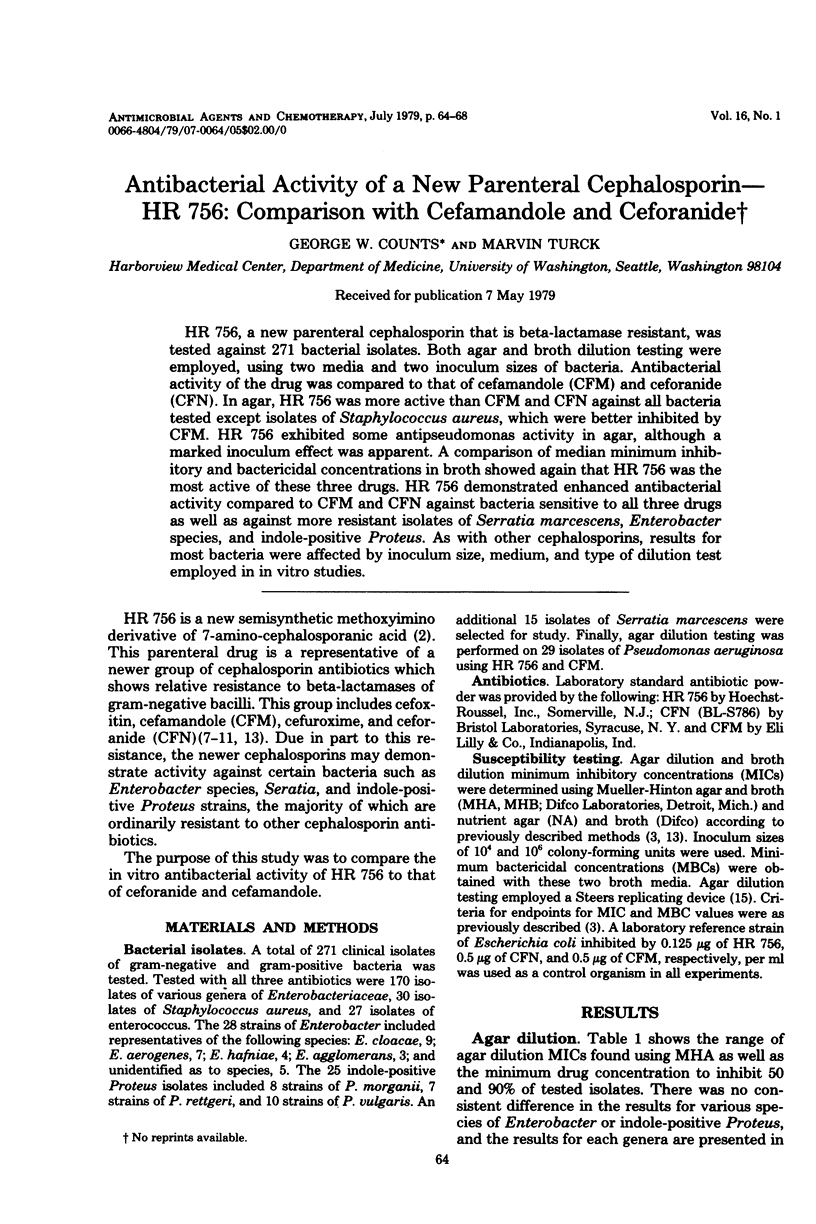
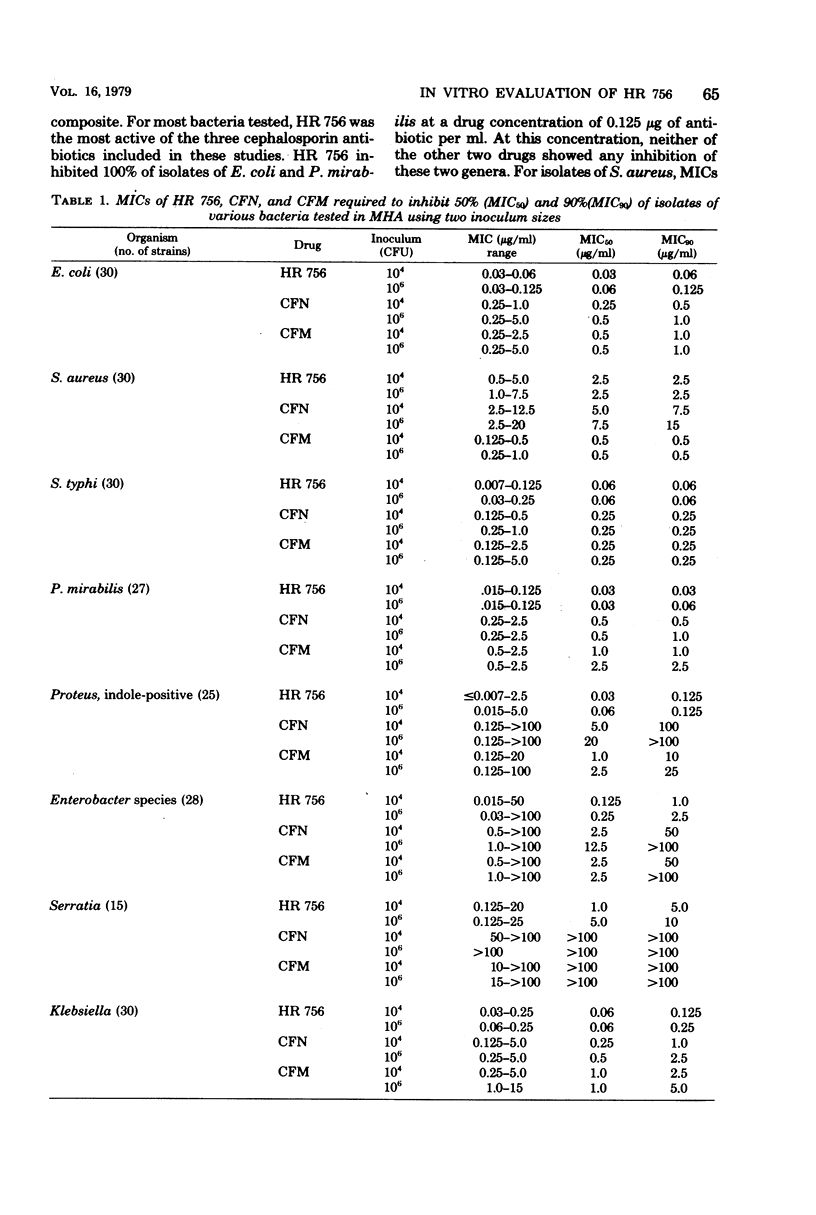
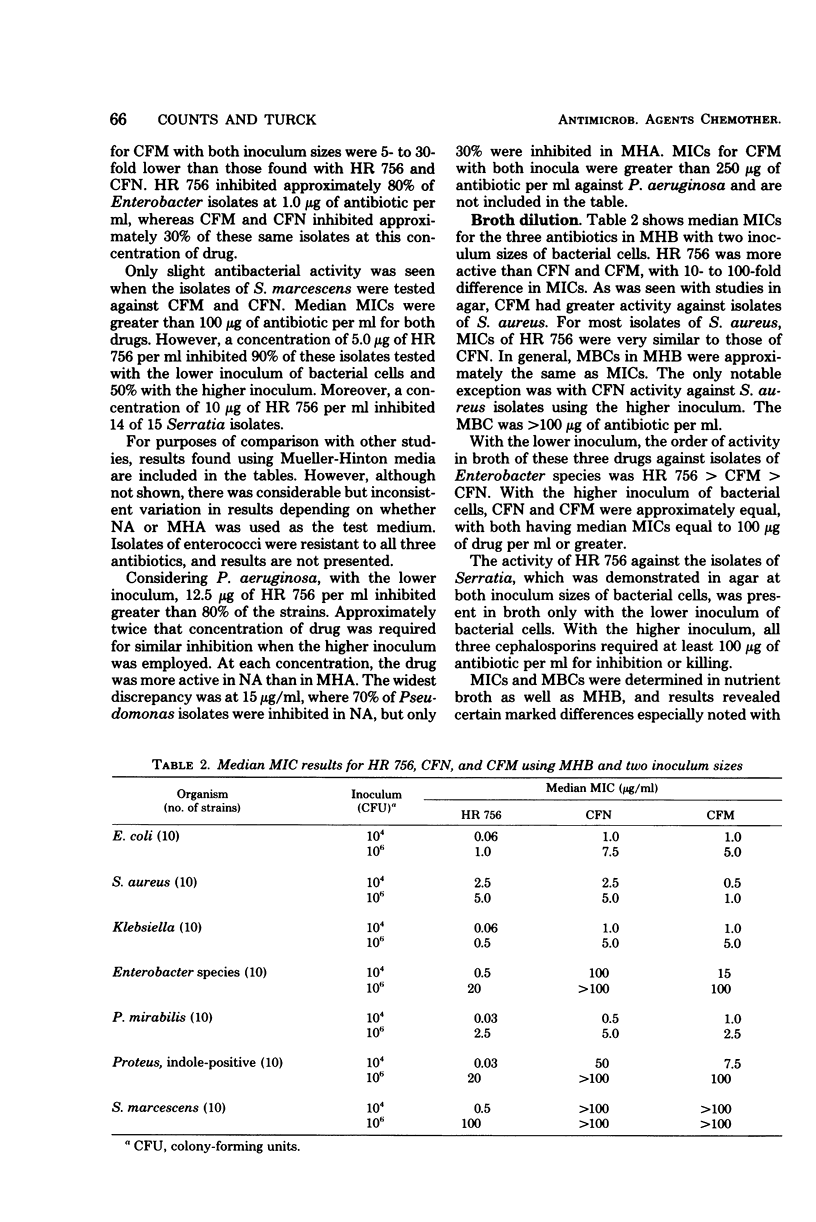
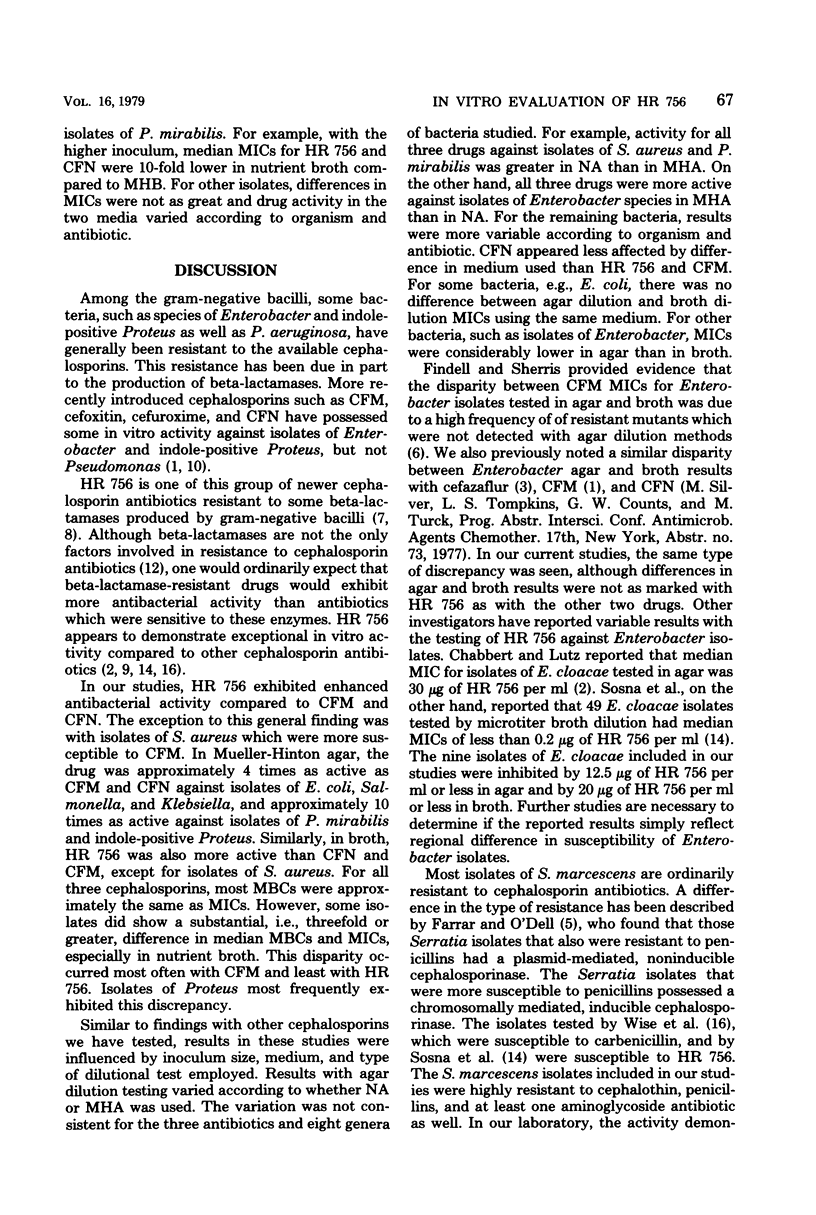
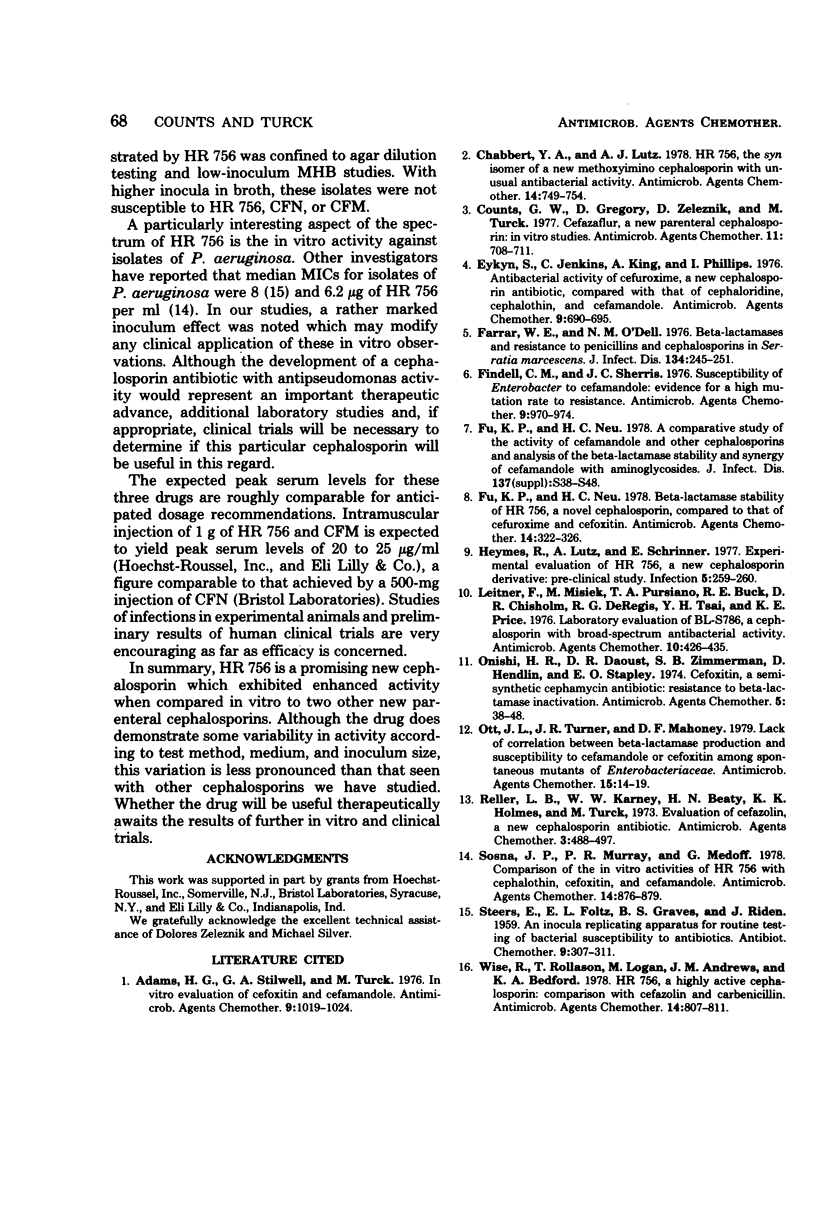
Selected References
These references are in PubMed. This may not be the complete list of references from this article.
- Adams H. G., Stilwell G. A., Turck M. In vitro evaluation of cefoxitin and cefamandole. Antimicrob Agents Chemother. 1976 Jun;9(6):1019–1024. doi: 10.1128/aac.9.6.1019. [DOI] [PMC free article] [PubMed] [Google Scholar]
- Chabbert Y. A., Lutz A. J. HR 756, the syn isomer of a new methoxyimino cephalosporin with unusual antibacterial activity. Antimicrob Agents Chemother. 1978 Nov;14(5):749–754. doi: 10.1128/aac.14.5.749. [DOI] [PMC free article] [PubMed] [Google Scholar]
- Counts G. W., Gregory D., Zeleznik D., Turch M. Cefazaflur, a new parenteral cephalosporin: in vitro studies. Antimicrob Agents Chemother. 1977 Apr;11(4):708–711. doi: 10.1128/aac.11.4.708. [DOI] [PMC free article] [PubMed] [Google Scholar]
- Eykyn S., Jenkins C., King A., Phillips I. Antibacterial activity of cefuroxime, a new cephalosporin antibiotic, compared with that of cephaloridine, cephalothin, and cefamandole. Antimicrob Agents Chemother. 1976 Apr;9(4):690–695. doi: 10.1128/aac.9.4.690. [DOI] [PMC free article] [PubMed] [Google Scholar]
- Farrar W. E., Jr, O'dell N. M. beta-Lactamases and resistance to penicillins and cephalosporins in Serratia marcescens. J Infect Dis. 1976 Sep;134(3):245–251. doi: 10.1093/infdis/134.3.245. [DOI] [PubMed] [Google Scholar]
- Findell C. M., Sherris J. C. Susceptibility of Enterobacter to cefamandole: evidence for a high mutation rate to resistance. Antimicrob Agents Chemother. 1976 Jun;9(6):970–974. doi: 10.1128/aac.9.6.970. [DOI] [PMC free article] [PubMed] [Google Scholar]
- Fu K. P., Neu H. C. A comparative study of the activity of cefamandole and other cephalosporins and analysis of the beta-lactamase stability and synergy of cefamandole with aminoglycosides. J Infect Dis. 1978 May;137 (Suppl):S38–S50. doi: 10.1093/infdis/137.supplement.s38. [DOI] [PubMed] [Google Scholar]
- Fu K. P., Neu H. C. beta-lactamase stability of HR 756, a novel cephalosporin, compared to that of cefuroxime and cefoxitin. Antimicrob Agents Chemother. 1978 Sep;14(3):322–326. doi: 10.1128/aac.14.3.322. [DOI] [PMC free article] [PubMed] [Google Scholar]
- Heymès R., Lutz A., Schrinner E. Experimental evaluation of HR756, a new cephalosporin derivative: pre-clinical study. Infection. 1977;5(4):259–260. doi: 10.1007/BF01640793. [DOI] [PubMed] [Google Scholar]
- Leitner F., Misiek M., Pursiano T. A., Buck R. E., Chisholm D. R., DeRegis R. G., Tsai Y. H., Price K. E. Laboratory evaluation of BL-S786, a cephalosporin with broad-spectrum antibacterial activity. Antimicrob Agents Chemother. 1976 Sep;10(3):426–435. doi: 10.1128/aac.10.3.426. [DOI] [PMC free article] [PubMed] [Google Scholar]
- Onishi H. R., Daoust D. R., Zimmerman S. B., Hendlin D., Stapley E. O. Cefoxitin, a semisynthetic cephamycin antibiotic: resistance to beta-lactamase inactivation. Antimicrob Agents Chemother. 1974 Jan;5(1):38–48. doi: 10.1128/aac.5.1.38. [DOI] [PMC free article] [PubMed] [Google Scholar]
- Ott J. L., Turner J. R., Mahoney D. F. Lack of correlation between beta-lactamase production and susceptibility to cefamandole or cefoxitin among spontaneous mutants of Enterobacteriaceae. Antimicrob Agents Chemother. 1979 Jan;15(1):14–19. doi: 10.1128/aac.15.1.14. [DOI] [PMC free article] [PubMed] [Google Scholar]
- Reller L. B., Karney W. W., Beaty H. N., Holmes K. K., Turck M. Evaluation of cefazolin, a new cephalosporin antibiotic. Antimicrob Agents Chemother. 1973 Apr;3(4):488–497. doi: 10.1128/aac.3.4.488. [DOI] [PMC free article] [PubMed] [Google Scholar]
- Sosna J. P., Murray P. R., Medoff G. Comparison of the in vitro activities of HR756 with cephalothin, cefoxitin, and cefamandole. Antimicrob Agents Chemother. 1978 Dec;14(6):876–879. doi: 10.1128/aac.14.6.876. [DOI] [PMC free article] [PubMed] [Google Scholar]
- Wise R., Rollason T., Logan M., Andrews J. M., Bedford K. A. HR 756, a highly active cephalosporin: comparison with cefazolin and carbenicillin. Antimicrob Agents Chemother. 1978 Dec;14(6):807–811. doi: 10.1128/aac.14.6.807. [DOI] [PMC free article] [PubMed] [Google Scholar]


